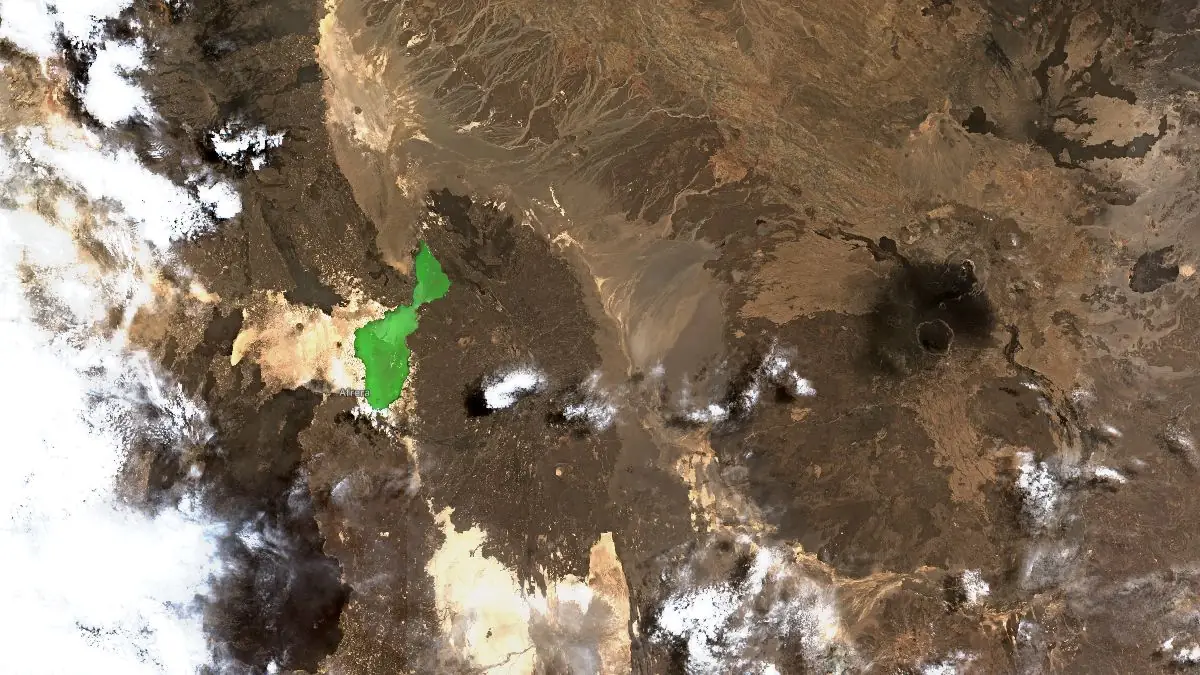Deep Earth pulses detected beneath Afar rift where Africa is slowly splitting apart
Scientists have detected rhythmic pulses of hot mantle material rising from deep beneath East Africa’s Afar rift system — a region where the continent is gradually breaking apart along three tectonic rift arms. Based on over 130 volcanic rock samples, the study shows that the mantle upwelling is compositionally varied and shaped by differences in crustal thickness and spreading rates across the Red Sea, Gulf of Aden, and Main Ethiopian rifts.

Afrera, Ethiopia satellite image acquired on June 28, 2025. Credit: CopernicusEU/Sentinel-2, The Watchers
A new study in Nature Geoscience, led by researchers from the University of Southampton, reveals that the mantle upwelling beneath East Africa’s Afar triple junction, a geologically complex region where the Arabian, Nubian, and Somalian plates meet, is not only compositionally heterogeneous but also dynamic. Scientists detected rhythmic pulses of hot mantle material rising from depth, interacting differently with the overlying lithosphere depending on local tectonic conditions.
The Afar region is one of the few places on land where active continental rifting is occurring. It marks the meeting point of three tectonic plates and is part of a broader zone where the African continent is gradually breaking apart. Using new geochemical data alongside existing records, researchers show that a single, pulsing mantle upwelling sits beneath the region. This upwelling interacts differently with each of the three rift arms, shaped by differences in crustal thickness and spreading rates.
The team analyzed over 130 Quaternary volcanic rock samples from across the Red Sea Rift (RSR), the Gulf of Aden Rift (GoA), and the Main Ethiopian Rift (MER), doubling the existing geochemical dataset. They measured major and trace element compositions, along with radiogenic isotopes (Strontium, Neodymium, Lead), and correlated these with seismic velocities and crustal thickness data.
A wide range in isotopic ratios and trace-element indicators was found, supporting a model of compositional heterogeneity in the upwelling mantle source. These chemical patterns repeat across the rift system, suggesting episodic pulses of melt ascending from depth. Incorporating statistical models like semi-parametric regression with splines and K-means cluster analysis, the researchers tested multiple geodynamic scenarios.
The best-performing model (C1D) featured a single mantle upwelling that is compositionally varied across space, producing distinct geochemical patterns along each rift. Melt production and composition change with distance from the center of the upwelling, but each rift arm shows a different response to this variation.
The Red Sea Rift, which has faster extension rates (14.5–15.5 mm per year / 0.57–0.61 inches per year) and thinner crust (16–25 km / 10-15.5 miles), shows broader geochemical variations, pointing to more efficient mantle flow and melt movement. The Main Ethiopian Rift, with slower extension (around 5.2 mm per year / 0.20 inches per year) and thicker crust (25–33 km / 15.5-20.5 miles), displays more tightly spaced geochemical changes, suggesting that mantle flow is more restricted there.
Seismic velocity data, with shear-wave speeds ranging from 3.81 to 4.17 km/s (2.37 to 2.59 mps) at depths between 40 and 120 km (25 to 75 miles), support the presence of partial melt zones beneath the rift axes.
Changes in the ratios of lanthanum to samarium (La/Sm) and niobium enrichment across the region reflect differences in how much mantle melting is happening and possibly how deep that melting starts. There’s also a clear inverse link between cerium to lead (Ce/Pb) ratios and crustal thickness, which suggests that in most places the magma hasn’t picked up much material from the crust on its way up.
Cluster analysis revealed recurring geochemical patterns across the different rift arms, interpreted as distinct melt pulses distributed between rifts and shaped by local tectonic conditions. These geochemical clusters do not align with surface volcanic segmentation, indicating deep mantle processes, potentially pulsing, from beneath the base of the lithosphere.
The findings show that lithospheric dynamics play a central role in shaping mantle upwellings during continental rifting. Rather than being solely plume-driven, the evolution of mantle-derived magmatism at Afar is controlled by the geometry and mechanics of the overlying plate.
Consequently, this work adds to growing evidence that mantle plumes feeding continental rifts can be compositionally different and strongly influenced by the structure and dynamics of the plate on top.
References:
1 Mantle upwelling at Afar triple junction shaped by overriding plate dynamics – Emma J. Watts, Rhiannon Rees, Philip Jonathan, Derek Keir, et al. – Nature Geoscience – June 25, 2025 – DOI https://doi.org/10.1038/s41561-025-01717-0 – OPEN ACCESS
My passions include trying my best to save a dying planet, be it through carpooling or by spreading awareness about it. Research comes naturally to me, complemented by a keen interest in writing and journalism. Guided by a curious mind and a drive to look beyond the surface, I strive to bring thoughtful attention and clarity to subjects across Earth, sciences, environment, and everything in between.



Commenting rules and guidelines
We value the thoughts and opinions of our readers and welcome healthy discussions on our website. In order to maintain a respectful and positive community, we ask that all commenters follow these rules.